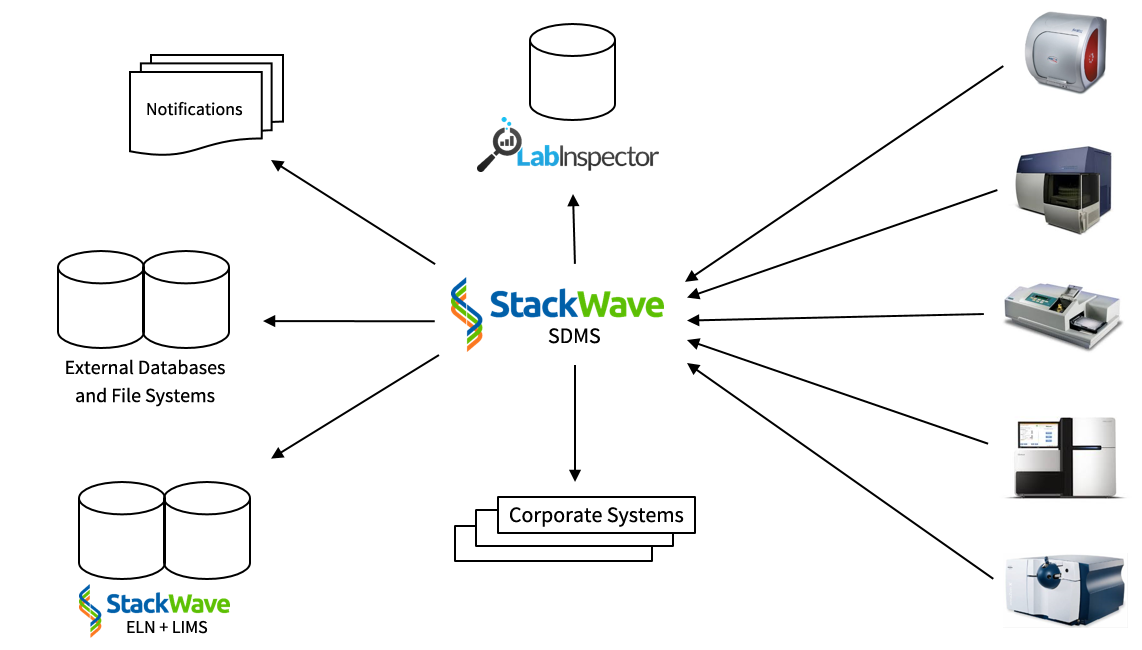StackWave SDMS
StackWave's Scientific Data Management System (SDMS) enhances the intelligence of your instruments. It goes beyond basic document management and data collection, actively monitoring laboratory systems, triggering processes, transforming assay data, and reacting to key events.

Automate your workflows
Add intelligence to your instruments with StackWave's Scientific Data Management System (SDMS); our software takes SDMS to the next level. More than a simple document management and data collection tool, StackWave SDMS actively monitors your laboratory systems for key events and can send notifications, trigger key downstream processes, transform and transmit assay data, and react to downstream events using StackWave's highly configurable LabReact technology. In combination with the powerful asset management features of LabInspector, StackWave SDMS can provide a more complete picture of your laboratory's operation.

Monitor your devices for key events, errors, maintenance operations, and more. Track environmental conditions such as humitidy, temperature, and light exposure. With StackWave SDMS, you can truly bring the promise of the Internet of Things into your lab.
Execute downstream processes based on events that happen on your automated system. The StackWave SDMS is the perfect solution for kicking off QC scripts, automating data processing and analysis, or scheduling subsequent runs based on the conditions of the current run.
Passively track barcode associations on your automated robotic systems. Get rid of outdated mechanisms for tracking source and destination barcodes. Use the StackWave SDMS to track and store barcode associations to be queried by downstream analysis methods.
Automatically discover newly generated assay result data. StackWave SDMS can transform that assay data and import it directly into an external system, such as the StackWave LIMS, StackWave ELN, or any existing system that may be in place in your laboratory.
Request a demo of StackWave SDMS

"StackWave gives us confidence in our leads by collecting all of the data about our potential therapeutics in one place and making that data actionable by allowing us to compare antibodies of interest."
"I worked with StackWave for ~4 years at my previous job to implement our LIMS. It was a great learning experience. We put in place an incredible system for our entire workflow, from plasmid registration to in-vivo study data registration."
"StackWave’s Platform allowed us to collaborate on our in-vivo studies in a web browser at home... I would highly recommend StackWave for therapeutic discovery teams looking to improve collaboration between teams."
Related Content
The Benefits of Implementing a Scientific Data Management System
Laboratory experiments require a lot of data and experiments need to be as accurate as possible, but the manual collection and management of such data can be time-consuming, error-prone, and overwhelming. The volume of data generated from laboratory experiments is increasing daily, and there is a need for an efficient way to organize, store and access these data. This is where a scientific data management system comes into play. In this article, we will be discussing the benefits of implementing a scientific data management system to automate lab instrument output collection and publishing.
Automating Collection of Lab Device Output with a Scientific Data Management System
Automate lab data collection with a scientific data management system to increase efficiency, reduce errors, improve storage and analysis, and make better data-driven decisions.
Integrating Scientific Data Management and LIMS in Biologics Drug Discovery
Explore the crucial integration of SDMS and LIMS in biologics drug discovery, enhancing data management, automation, and collaboration for scientists and managers.